THE MUNICIPAL COURT
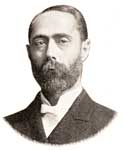 JUDGE GRIER M. ORR
JUDGE GRIER M. ORR
An enthusiast once remarked that a true Irish gentleman is the finest in the world, and though such a remark must naturally be criticized as too limited in application, all who have known well born Irishmen must in a measure agree. Of Hon. Grier M. Orr, Judge of the Municipal Court, the least that can be said is that it is a pleasure to know him, for so intimately blended are innate courtesy and a genial presence that an hour's conversation is quite as refreshing as it is instructive. He comes of Revolutionary stock. his great grandfather, Robert Orr, having emigrated to Pennsylvania from County Donegal, Ireland, in 1765. After a great deal of fighting as captain of a company formed to protect the borderland during the Revolutionary and French and Indian wars, Robert Orr settled down as sheriff and associate judge of Clarion county, Pa. In this same county the present judge, Grier M. Orr, was born, May 14, 1856. He was educated at Tiffin College and studied law in Cincinnati. In 1883 he was admitted to the bar and located in Lima, 0., as a member of the firm of Richie, Richie & Orr, shortly after coming to St. Paul. Jan. 1, 1885, he became one of the firm of Romans & Orr, and upon the dissolution of this partnership in 1892, practiced alone for two years. His election as one of the judges of the municipal court occurred in May, 1894, since which time he has served on the bench continuously.
Judge Orr was married to one of Rochester's most popular young ladies Aug. 12, 1896, and a dear little two year-old named Helen, the image of her father, now graces the family circle.
Judge Orr possesses not only Irish wit and Irish logic, but an abundance of human sympathy which is too wide to be classed as a national characteristic. And as a natural result he can find among his many friends a goodly proportion of earth's unfortunates for whom he always has a kind word and a ready hand — that is, if they deserve it. Otherwise he is simply — Judge Orr, of the Municipal Court.
His home is on Iris pl., Union Park.
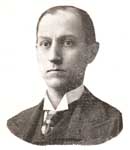 JUDGE ROBERT C. HINE
JUDGE ROBERT C. HINE
It needs but a glance at the firm, classic features of the junior judge on the municipal bench, Hon. Robert C. Hine, to determine that he is wholly and--soully--a scholar. A certain well-bred, intellectual ease, a stateliness of manner, albeit tinged with cordiality, all testify to that. He was born in Stamford, Conn., June 6, 1860, of English-Dutch parentage and can claim some of the oldest families in New England as ancestral kindred. He was early given the best schooling to be obtained in Stamford and then sent to a military and preparatory school in New York. After that he went to Yale College, from which he graduated in 1881, finishing his studies at the Columbia Law School in New York. Receiving his diploma there in 1883, he practiced law in New York City until 1887 as a member of the firm of Thompson & Ackley. He was also for a time associated with Hon. Simon Sterne. On coming to St. Paul in July, 1887, he formed a partnership with Edward B. Graves, which lasted until 1892. From that time until his election in May, 1898, as the Republican nominee, he practiced independently. He is a popular favorite in the 4th, 7th and 9th Wards, where he has lived during his residence in St. Paul, and as a brilliant young legal light of undoubted integrity and manly honor is likely to receive continued favor at the hands of his party. As a humane judge who is determined to mete out just punishment to transgressors who prey upon children and dumb animals, he has already endeared himself to the community at large.
June 18, 1891, Judge Hine was married to Miss Mary E. Bidleman, of St. Paul. John A., a bright lad of seven, and Robert V. N., an infant, are the only children.
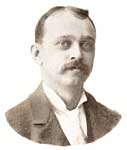 GEORGE BEALZ
GEORGE BEALZ
The present municipal court stenographer is George Bealz, a very able young attorney, who was admitted to the St. Paul bar in 1896. Previous to this he had studied law in the office of Young & Lightner. Mr. Bealz was born in 1866 in New York City, where he received his education, coming to St. Paul in 1887. He was appointed court reporter in June, 1898. He lives at No. 186 Smith av. N.
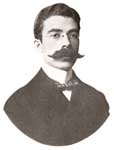 FRANK ARNOLD
FRANK ARNOLD
The second assistant city attorney, is an Englishman, born in Chester and thirty-two years of age last July. In April, 1890, he crossed the Atlantic and took up his residence in Winnipeg, Manitoba, Canada. A year after he came to St. Paul and entered the employ of the Taylor-Craig Co., as bookkeeper. August, 1893, Mr. Arnold was given a position with J. W. Shepard, rental agent, and remained four years, attending the evening law classes at the University of Minnesota during that time. In June, 1897, he was admitted to the bar, and soon after engaged in active practice with an office in the New York Life Building. During the summer of 1898 he became a clerk in the office of the corporation attorney, on May 2, 1899, was promoted to the position of city prosecutor in the municipal court, and on Oct. 1, 1899, he assumed the position of second assistant city attorney, for which he is admirably fitted. He lives at No. 14 The Newport, St. Peter st.
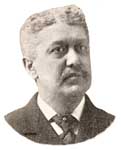 JOHN QUINCY ADAMS
JOHN QUINCY ADAMS
Bailiff and Acting Clerk of the Civil Branch of the Municipal Court of St. Paul.
John Quincy Adams is a native of Louisville, Ky., and is 50 years of age. His father, Rev. Henry Adams, was the most prominent Afro-American Baptist preacher of that state. He began public life as a teacher in his father's school, then taught in other parts of the state. In 1870 he went to Arkansas and taught school in the district of which John M. Clayton, the murdered brother of the then governor, Powell Clayton, was superintendent. He took considerable interest in politics and was secretary of two state conventions. He was elected justice of the peace on the same ticket with President Grant, then engrossing clerk of the senate of 1873. Afterwards he was assistant superintendent of public instruction of the state and subsequently deputy commissioner of public works. After the Democrats gained possession of the state he returned to Louisville and with his younger brother, Cyrus Field Adams, began the publication of a weekly paper, the Bulletin, of which he was editor for seven years. In this work he gained a national reputation and was elected as the first president of the National Afro-American Newspaper Association, serving two terms. In his native city he was quite a prominent figure in the councils of the Republican party, serving on the city and state executive committees, and was elected alternate delegate to the Republican National convention of 1880. He also saw something of public life, serving five years in the revenue service as storekeeper in the Fifth Kentucky district. When President Cleveland was elected he was forced to resign from the revenue service. He also sold the Bulletin and in 1886 came to St. Paul and at once secured a position on The Appeal, of which he has since acquired the proprietorship.
During his residence in this city he has figured prominently in its affairs, and has been an active worker in the ranks of the Republican party.
Mr. Adams has been recognized by his party in this state and had the honor of being the first Afro-American delegate sent to a state convention in Minnesota. He was a member of the delegation which went to Washington to secure the Republican National convention for, and is credited with having secured the votes which gave the convention to Minneapolis. In addition to these honors, Mr. Adams has served on local and congressional committees, and has been president of several Republican clubs. He was appointed bailiff of the municipal court by Mayor F. B. Doran in June, 1896, was retained by Mayor A. R. Keifer, anu is now acting as clerk of the civil branch of the court. He married a St. Paul lady in 1892, and is the happy father of three girls and a boy.
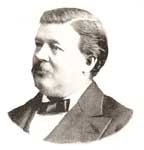 HANS N. CLOUSE
HANS N. CLOUSE
Is the deputy clerk of the municipal court. Born in Sweden fifty-three years ago, he came to St. Paul in 1868. From that time until May 1, 1875, when he was appointed a patrolman, he was the proprietor of the Lewiston House, a popular hostelry situated on Jackson st. After walking a beat for six years Officer Clouse received a well deserved promotion to the office of bailiff of the municipal court. In 1887 he was given his present position. He is a widower and lives at 301 Williams st.
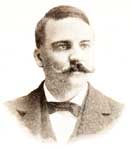 EDWIN M. PARISH
EDWIN M. PARISH
For general jollity and good fellowship it would be hard to find an office to equal that of the bailiffs of the municipal court, and Edwin M. Parish is one of the brightest stars of the constellation. He was born in Warsaw, N. Y., and comes of revolutionary stock, his forefathers having located in Vermont long before the first war. When fifteen he came to St. Paul and went to school in both the Madison and the high schools, graduating at the latter. After that he became a commercial traveler, and was in business for himself previous to his appointment as a bailiff in July, 1898. He is married and lives at No. 117 Bates av.
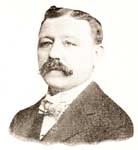 JOHN THILL
JOHN THILL
In the police force as in the whole of life, a little inquiry will often reveal the fact that there is a great deal more music "in the air," and in the souls of men than people dream of.
John Thill is one of the department's ablest musicians. He is a Luxemburger, in the prime of life, and has lived in St. Paul since 1877, coming to that city direct from Germany, where he was a commercial traveler. Shortly after his arrival in St. Paul he opened a billiard hall, running it two years, and then becoming proprietor of the. St. Paul hotel. Eight years of hotel life and nine as the owner of the Germania Buffet followed. Between times he was one of the organizers of the Great Union Band, and played with it two years. He was appointed a bailiff of the municipal court in July, 1898, and is still serving. He resides at No. 676 Edmund st.

